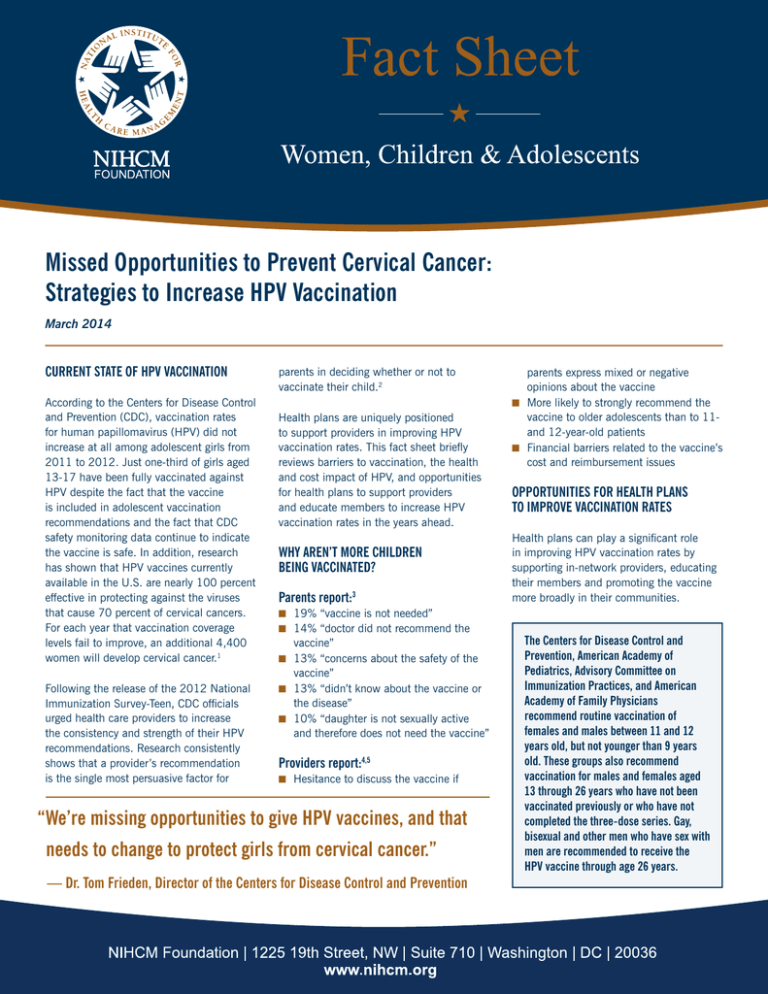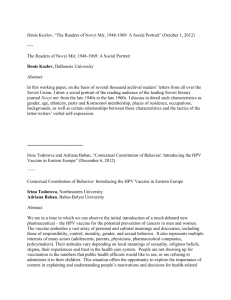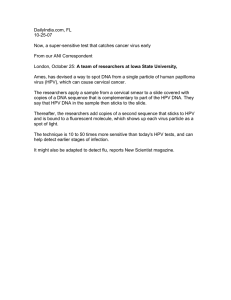Missed Opportunities to Prevent Cervical Cancer: Strategies to Increase HPV Vaccination
advertisement

Missed Opportunities to Prevent Cervical Cancer: Strategies to Increase HPV Vaccination March 2014 CURRENT STATE OF HPV VACCINATION According to the Centers for Disease Control and Prevention (CDC), vaccination rates for human papillomavirus (HPV) did not increase at all among adolescent girls from 2011 to 2012. Just one-third of girls aged 13-17 have been fully vaccinated against HPV despite the fact that the vaccine is included in adolescent vaccination recommendations and the fact that CDC safety monitoring data continue to indicate the vaccine is safe. In addition, research has shown that HPV vaccines currently available in the U.S. are nearly 100 percent effective in protecting against the viruses that cause 70 percent of cervical cancers. For each year that vaccination coverage levels fail to improve, an additional 4,400 women will develop cervical cancer.1 Following the release of the 2012 National Immunization Survey-Teen, CDC officials urged health care providers to increase the consistency and strength of their HPV recommendations. Research consistently shows that a provider’s recommendation is the single most persuasive factor for parents in deciding whether or not to vaccinate their child.2 Health plans are uniquely positioned to support providers in improving HPV vaccination rates. This fact sheet briefly reviews barriers to vaccination, the health and cost impact of HPV, and opportunities for health plans to support providers and educate members to increase HPV vaccination rates in the years ahead. WHY AREN’T MORE CHILDREN BEING VACCINATED? Parents report:3 ■ 19% “vaccine is not needed” ■ 14% “doctor did not recommend the vaccine” ■ 13% “concerns about the safety of the vaccine” ■ 13% “didn’t know about the vaccine or the disease” ■ 10% “daughter is not sexually active and therefore does not need the vaccine” Providers report:4,5 ■ Hesitance to discuss the vaccine if “We’re missing opportunities to give HPV vaccines, and that needs to change to protect girls from cervical cancer.” — Dr. Tom Frieden, Director of the Centers for Disease Control and Prevention parents express mixed or negative opinions about the vaccine ■ More likely to strongly recommend the vaccine to older adolescents than to 11and 12-year-old patients ■ Financial barriers related to the vaccine’s cost and reimbursement issues OPPORTUNITIES FOR HEALTH PLANS TO IMPROVE VACCINATION RATES Health plans can play a significant role in improving HPV vaccination rates by supporting in-network providers, educating their members and promoting the vaccine more broadly in their communities. The Centers for Disease Control and Prevention, American Academy of Pediatrics, Advisory Committee on Immunization Practices, and American Academy of Family Physicians recommend routine vaccination of females and males between 11 and 12 years old, but not younger than 9 years old. These groups also recommend vaccination for males and females aged 13 through 26 years who have not been vaccinated previously or who have not completed the three-dose series. Gay, bisexual and other men who have sex with men are recommended to receive the HPV vaccine through age 26 years. Health plans can support and reinforce providers’ efforts by:6,7 ■ Increasing the consistency and strength of HPV vaccine recommendations ■ Recommending that HPV vaccine be offered at every health care encounter ■ Developing incentives based on HPV vaccination measures ■ Encouraging the reporting of HPV vaccinations to state or local immunization registries ■ Urging that reminder notices be sent to parents of patients who are due to receive the HPV vaccine Provider Education Materials ■ CDC HPV Vaccination Resources for Healthcare Professionals: http://tinyurl.com/bqn2ckj ■ Provider fact sheet for talking to parents about the HPV vaccine: http://tinyurl.com/kt3bhpj ■ HPV Toolkit for providers American Sexual Health Association: http://tinyurl.com/kdhlxlw ■ Minnesota Quality Collaborative, Health Plan Performance Improvement Project: HPV Vaccination: http://tinyurl.com/nxczt82 Health plans can educate their members and their local communities about the importance of adolescent HPV immunization by disseminating educational materials via:8,9 ■ Newsletters designed specifically for both adolescents and parents ■ Attendance at health fairs and community events ■ Fact sheets ■ Social media like Twitter, YouTube or Facebook ■ Segments on local television or radio stations ■ Email and letters to parents of members eligible for the HPV vaccine Parent and Patient Education Materials ■ Healthcare Triage — The HPV Vaccine and Why Your Kids Should Get It (YouTube video): http://tinyurl.com/ m9hlaa3 ■ CDC Feature article on HPV: http://tinyurl. com/mmgpxkj ■ CDC Reminder e-cards: http://tinyurl. com/ka3kmju ■ CDC HPV fact sheet for young women: http://tinyurl.com/nofq8z HEALTH PLAN EFFORTS TO PROMOTE HPV VACCINATION Minnesota Health Plan Collaborative Eight Minnesota health plans – Blue Plus, HealthPartners, Itasca Medical Care, Medica, Metropolitan Health Plan, PrimeWest Health, South Country Health Alliance and UCare – participated in a quality improvement project to increase HPV vaccination rates among 11- and 12-yearold girls enrolled in Medicaid between 2008 and 2011. The collaborative began the HPV vaccination project by reaching out to the girls’ parents through direct mailings about the importance of HPV vaccination. Next, the collaborative trained primary care providers and their staffs on how to report vaccinations through the Minnesota immunization recording system and shared educational materials about the HPV vaccine and the importance of ensuring girls receive all three doses. The collaborative offered continued training and technical assistance for primary care providers and staff. Finally, the collaborative engaged community organizations, including the state department of health and community health centers, to provide education and resources about the HPV vaccine’s benefits. The collaborative shared important information about the vaccine at more than 40 health fairs and exhibits throughout the state during the project time period. Between 2008 and 2011, HPV vaccination rates for the target population increased by ten percent. Based on the success of this initiative, a group of small county-based purchasing plans in Minnesota is implementing a similar HPV vaccination project. HPV PREVALENCE AND CONSEQUENCES Genital HPV is the most common and costly sexually transmitted disease in the United States. More than 14 million people will contract HPV this year, and annual direct medical costs are estimated to be $1.7 billion.10 Almost half of these new infections will be in young people between the ages of 15 and 24.11 By the time a woman reaches age 50, her risk of having or having had genital HPV is 80 percent.12 Sexually Transmitted Infection Rates in the US Per Year: Hep B 19,000 HIV 41,400 Syphilis 55,400 Herpes Simplex Virus (Type 2) 776,000 Gonorrhea 820,000 Trichomoniasis 1,090,000 Chlamydia 2,860,000 Human Papilloma Virus 14,100,000 Source: Statistics on Sexually Transmitted Infections, American Sexual Health Association, www. ashasexualhealth.org While the majority of cases will clear up on their own, some types of HPV will develop into more serious health problems such as: ■ Cervical cancer ■ 99.7 percent of cervical cancer is caused by HPV13 ■ Cervical cancer is the second leading cause of cancer death in women ■ More than 12,000 women will develop invasive cervical cancer this year14 ■ Cancer of the vulva, vagina, penis, anus and oropharynx ■ Genital warts ■ Recurrent respiratory papillomatosis (RRP)15 — warts in the throat that can block the airway and can be passed from infected mother to fetus “By increasing 3-dose HPV vaccination coverage to 80 percent, an estimated additional 53,000 cases of cervical cancer could be prevented over the lifetimes of those aged 12 or younger.” — CDC MMWR June 2013 BlueCross BlueShield of Western New York BlueCross BlueShield of Western New York (BCBSWNY) disseminates educational and informative articles about the value of HPV vaccination in both its member and provider newsletters. The articles describe the importance of the three-shot sequence and encourage members to return for all three shots in the series. From December 2010 through January 2014, BCBSWNY sponsored a local television show, The Healthy Zone, where guest speakers discussed the importance of the HPV vaccine and a variety of other health topics. In 2014, BCBSWNY changed the format and the name to Healthy Zone On The Go. This one-minute segment airs at various times throughout the week and features speakers on a variety of health topics, including the HPV vaccine. The segment reaches nearly 1,000,000 adults ENDNOTES 1 Centers for Disease Control and Prevention. “Human Papillomavirus Vaccination Coverage Among Adolescent Girls.” 2007-2012, and “Postlicensure Vaccine Safety Monitoring.” 2006-2013. Morbidity and Mortality Weekly Report, July 26, 2013. 62(29);591-595. 2 Centers for Disease Control and Prevention. Telebriefing on human papillomavirus (HPV) vaccination coverage and vaccine safety monitoring. Press Briefing Transcript. July 25, 2013. Available at: http://tinyurl. com/q6ebxvk. Accessed November 22, 2013. 3 Morbidity and Mortality Weekly Report, July 26, 2013. 4 Bolan, G. Adolescents and STIs: A Nationwide Perspective. Presentation on NIHCM Foundation Webinar, July 2013. Available at: http://tinyurl.com/ mu2b79b. Accessed March 12, 2014. 5 Daley MF, Crane LA, Markowitz LE, et al. “Human papillomavirus vaccination practices: a survey of US physicians 18 months after licensure.” Pediatrics 2010;126:425–33. ages 21 and over through television and online viewers. examples about how to make a strong HPV recommendation was also disseminated. Health Net For parents/guardians of girls ages 11 and 12, Health Net Federal Services began sending letters with reminders about HPV vaccination. For girls who had not started the vaccine, the letter provided HPV information and education and encouraged parents to talk to their child’s doctor. It also included a brief personal story and picture from a mother with cervical cancer who wanted to make sure her daughter was protected. A second letter, targeting girls who had started the vaccine series but not yet completed it, sought to remind parents to follow through with the series. In an effort to improve HPV vaccination rates, Health Net Federal Services, LLC (Health Net Federal Services) has recently begun reaching out to members, parents and providers with information about the importance of the HPV vaccine. Before starting any outreach efforts, Health Net Federal Services first met with academic experts in HPV prevention, outreach and communication to discuss best practices in HPV vaccine education. In addition to general educational messaging about HPV and HPV vaccination, Health Net Federal Services addresses issues of vaccine safety and parental concerns that may exist about the vaccine encouraging recipients to engage in sexual activity. After gaining a more thorough understanding of how to communicate information about HPV, Health Net Federal Services began with outreach to network providers, particularly pediatricians and family practitioners, through targeted emails and broader newsletters and via the web. Messaging sought to remind providers about the guidelines for HPV vaccination, as well as encourage providers both to review an adolescent patient’s immunization history at every visit, regardless of the reason for the visit, and to give a strong recommendation for all ageappropriate vaccinations, including HPV. A CDC fact sheet that included tips and 6 Morbidity and Mortality Weekly Report, July 26, 2013. 7 Centers for Disease Control and Prevention. How You Can Help: Strategies for Specific Groups. Supporting materials from NIS-Teen MMWR telebreifing, August 24, 2011. 8 Ibid. 9 Santoro K, Speedling C. The Case for Investing in Youth Health Literacy: One Step on the Path to Achieving Health Equity for Adolescents. Issue brief. October 2011. Available at: http://tinyurl.com/ lsddvit. Accessed November 22, 2013. 10 Owusu-Edusei K, et al. “The estimated direct medical cost of selected sexually transmitted infections in the United States, 2008.” Sexually Transmitted Diseases 2013; 40(3):197-201. 11 Centers for Disease Control and Prevention. Sexually Transmitted Infections among Young Americans. Available at: http://tinyurl.com/o6q65y8. Accessed October 24, 2013. 12 Disease Burden and Health Consequences of HPV Infection (Slides with Transcript). Medscape Multispecialty website. Available at: http://tinyurl. com/pj8lgtm. Accessed October 24, 2013. In August, to leverage both National Immunization Awareness Month and the back-to-school period, Health Net Federal Services sent targeted emails to parents and providers and posted general information on the web and Facebook to convey information about all age-appropriate adolescent vaccinations, including HPV. An automated outbound call campaign also provided general educational messaging to thousands of parents about adolescent vaccination. ADDITIONAL RESOURCES ■ CDC HPV vaccination websites: http://tinyurl.com/mr35pph http://tinyurl.com/lwehh7x ■ National HPV and Cervical Cancer Prevention Resource Center: http://tinyurl.com/muf4l5r 13 American Sexual Health Association. Statistics on Sexually Transmitted Infections. Available at: http:// tinyurl.com/m4ebvc6. Accessed October 24, 2013. 14 American Cancer Society. What are the key statistics about cervical cancer? Available at: http:// tinyurl.com/bfarwvl. Accessed October 24, 2013. 15 Centers for Disease Control and Prevention, Division of STD Prevention. Prevention of Genital HPV Infection and Sequelae: Report of an External Consultants’ Meeting. National Center for HIV, STD, and TB Prevention, Atlanta, December 1999. ABOUT NIHCM FOUNDATION The National Institute for Health Care Management (NIHCM) Foundation is a nonprofit, nonpartisan research and educational foundation dedicated to improving the effectiveness, efficiency and quality of the U.S. health care system.




